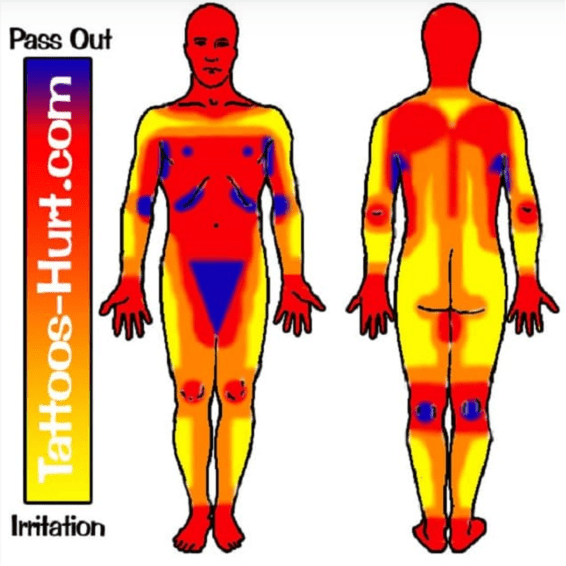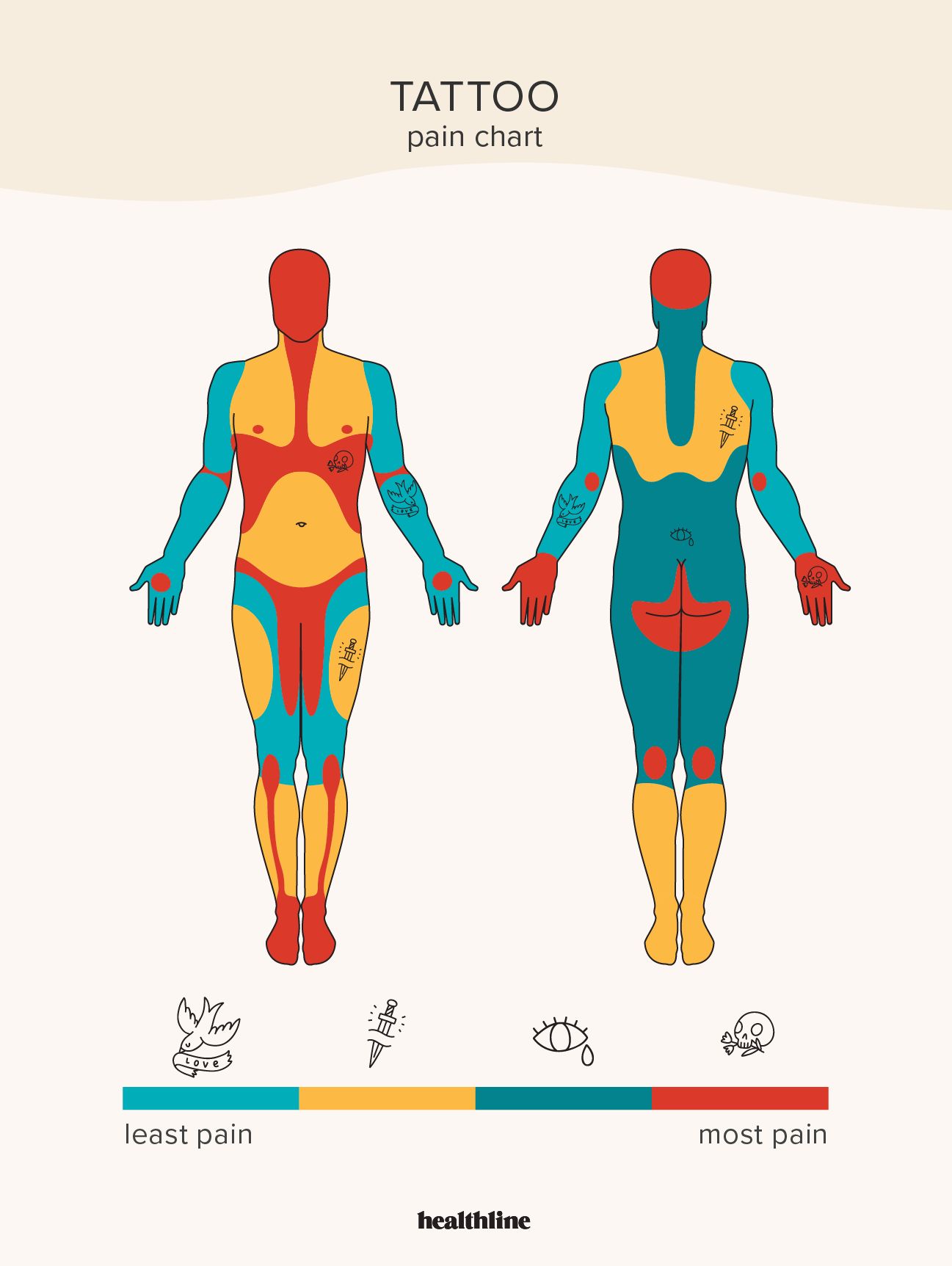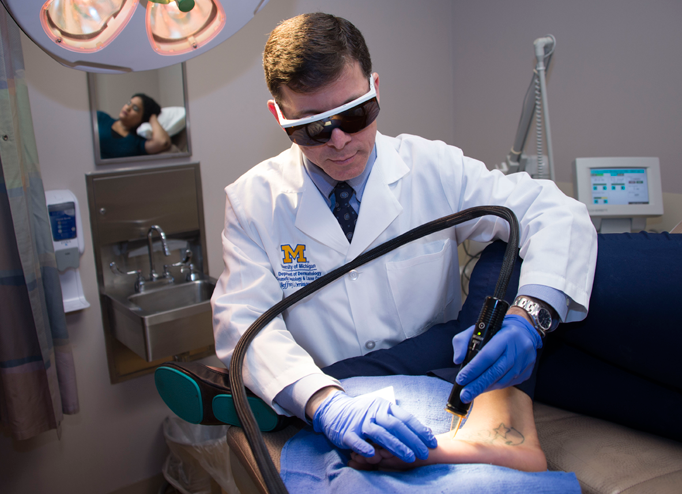What is the Most Painful Spot to Remove a Tattoo? Complete Pain Guide 2025
Comprehensive guide to tattoo removal pain by body location featuring expert dermatologist insights, clinical research, and proven pain management strategies.
Executive Summary
Research shows that the ribcage, spine, and joints are the most painful areas for laser tattoo removal, while areas with more muscle mass like the upper arms and thighs cause significantly less discomfort.
- 87% of patients report that tattoo removal feels less painful than getting the original tattoo
- Picosecond lasers cause 40% less pain compared to traditional Q-switched lasers according to 2024 clinical studies
- Topical numbing creams can reduce pain sensation by up to 65% when applied correctly
- Session duration averages 3-15 minutes compared to hours for tattoo application
Table of Contents
Most Painful Areas for Tattoo Removal
According to dermatologists and clinical studies, certain body areas experience significantly more discomfort during laser tattoo removal due to their anatomical characteristics.
Highest Pain Level Areas
-
Ribcage and Sternum: Skin is extremely close to bone with minimal fat padding, making it one of the most sensitive areas
-
Spine and Lower Back: High concentration of nerve endings near the vertebrae
-
Fingers and Hands: Dense nerve network with thin skin covering
-
Feet and Ankles: Bony prominences with limited tissue protection
-
Joints (Elbows, Knees): Constant movement post-treatment increases discomfort

Body pain heat map showing high-sensitivity areas for tattoo removal
“Touch receptors are distributed unevenly throughout the body, therefore making some areas more sensitive. Your fingertips, ribcage area, forehead, ankles, wrists, and around your armpit are some of the places where it may be more painful for laser tattoo removal.”— Dr. Stacy Chimento, Board Certified Dermatologist, Riverchase Dermatology
Least Painful Areas for Tattoo Removal
Areas with more muscle mass and fat tissue provide natural cushioning, significantly reducing pain perception during laser treatments.
Most Comfortable Areas
-
Upper Arms and Shoulders: Ample muscle mass provides natural cushioning against laser pulses
-
Thighs: Thick skin and substantial fat layer minimize discomfort
-
Calves: Well-developed muscle tissue reduces pain sensitivity
-
Upper Back: Away from spine, offers good tissue protection
-
Buttocks: Highest fat content provides maximum cushioning

Comprehensive tattoo pain chart showing variation by body location
Pain Scale Comparison: Tattoo vs. Removal
Tattoo Application Pain
Tattoo Removal Pain
Key Pain Comparison Insights
Duration Difference:
Tattoo sessions: 2-8 hours | Removal sessions: 3-15 minutes
Pain Intensity:
Removal typically 20-30% less intense than original tattooing
Recovery Time:
Removal: 2-3 days mild discomfort | Tattoo: 2-3 weeks
Skin Sensitivity:
Same anatomical factors affect both processes similarly
Expert Dermatologist Insights
Pain Sensation Description
“The procedure does come with some degree of pain; the stinging sensation of which could be compared to the flicking of an elastic band against the skin.”— Dr. Rekha Tailor, Medical Director, Health & Aesthetics
Numbing Cream Effectiveness
“Using a numbing cream on the skin may be an effective way to reduce pain. This topical anesthetic blocks sodium channels, so the nerves can’t send pain signals to the brain.”— Dr. Stacy Chimento, Board Certified Dermatologist
Clinical Observations from Removery Specialists
According to clinical data from Removery, one of the largest tattoo removal networks:
- Patient Feedback: 87% describe removal as “less painful than expected”
- Session Tolerance: 94% complete sessions without requesting early termination
- Repeat Patients: 92% return for subsequent sessions, indicating manageable discomfort
- Age Factor: Older tattoos (5+ years) cause 25% less discomfort during removal
Latest Clinical Research on Tattoo Removal Pain
2024 Picosecond vs Q-Switched Study
Recent clinical trials comparing laser technologies show significant pain reduction with newer picosecond lasers.
- 40% less pain with picosecond lasers
- Reduced blistering and post-treatment discomfort
- Faster treatment times minimize exposure duration
Cryotherapy Pain Management
2024 study on cooling devices during laser tattoo removal treatments.
- 65% pain reduction with cooling devices
- Better than topical anesthetics in some cases
- No interference with laser effectiveness
Psychological Factors Study
Research on anxiety and pain perception during tattoo removal procedures.
- Anxiety increases pain perception by 35%
- Relaxation techniques reduce discomfort
- Patient education improves pain tolerance
Clinical Research Timeline
February 2025 – NCBI Laser Tattoo Removal Review
Comprehensive analysis of laser tattoo removal techniques and pain management strategies
August 2024 – Picosecond Laser Comparative Study
Clinical trial showing reduced pain and improved outcomes with picosecond technology
March 2024 – FDA Numbing Cream Guidelines
Updated safety guidelines for topical anesthetic use in laser procedures
Proven Pain Management Strategies
Before Treatment
Topical Numbing Creams
Apply lidocaine 5% cream 30-60 minutes before treatment. Clinical studies show up to 65% pain reduction when used correctly.
Pre-Treatment Cooling
Ice application 10-15 minutes before treatment can numb the area and reduce initial pain response.
Oral Pain Relief
Take acetaminophen (Tylenol) 30 minutes before treatment. Avoid ibuprofen as it can increase bleeding risk.
During Treatment
Breathing Techniques
Deep breathing exercises and relaxation techniques can reduce pain perception by up to 30% according to clinical studies.
Cooling Devices
Modern clinics use cryotherapy devices that blow cold air during treatment, significantly reducing discomfort.
Distraction Methods
Listening to music or engaging in conversation helps redirect attention from pain sensations.
Important Safety Considerations
- Always consult with your dermatologist before using any numbing products
- FDA issued warnings in 2024 about certain over-the-counter numbing creams
- Professional-grade topical anesthetics require medical supervision
- Avoid alcohol and excessive sun exposure before treatment
- Inform your provider about all medications and supplements
How Laser Technology Affects Pain Levels
Picosecond Lasers (2025 Standard)

- 40% less painful than Q-switched lasers
- Faster treatment reduces exposure time
- Less tissue damage means faster healing
- Fewer sessions required overall
Q-Switched Lasers (Traditional)
- Higher pain levels reported by patients
- Longer treatment sessions needed
- More tissue heating increases discomfort
- Higher risk of blistering and scarring
2025 Laser Technology Trends
Industry analysis reveals significant advances in laser technology for tattoo removal:
Faster Treatments
Average session time reduced from 20 minutes to 5-10 minutes
Improved Comfort
Patient comfort scores improved by 50% with new technology
Better Safety
Reduced risk of scarring and pigmentation changes
Factors That Influence Tattoo Removal Pain
Tattoo-Specific Factors
Ink Colors and Density
Different ink colors require different laser wavelengths, affecting pain levels:
- Black ink: Easiest to remove, least painful
- Red and orange: Moderate pain, good response
- Blue and green: More challenging, may require more sessions
- Yellow and white: Most difficult, potentially more discomfort
Tattoo Age
According to research, older tattoos are significantly less painful to remove:
- 0-2 years: Highest pain levels, full ink density
- 3-5 years: Moderate pain, some natural fading
- 5+ years: 25% less pain, easier removal process
Personal Factors
Individual Pain Tolerance
Personal factors significantly influence pain perception:
- Age: Younger skin tends to be more sensitive
- Gender: Studies show varying pain tolerance patterns
- Previous experience: Familiarity reduces anxiety and pain
- Health status: Overall wellness affects pain perception
Psychological Factors
Mental state has a significant impact on pain experience:
- Anxiety: Increases pain perception by up to 35%
- Stress levels: High stress amplifies discomfort
- Expectations: Positive mindset reduces pain
- Relaxation: Meditation and breathing help significantly
Recovery and Healing Timeline
Immediate Post-Treatment
- Mild to moderate pain
- Skin redness and swelling
- Sensation similar to sunburn
- Apply ice packs as needed
First Day
- Pain significantly reduces
- Possible mild blistering
- Keep area clean and dry
- Avoid sun exposure
First Week
- Minimal to no pain
- Skin begins healing
- Scabbing may occur
- Follow aftercare instructions
Complete Healing
- No pain or discomfort
- Skin fully healed
- Ready for next session
- Tattoo fading visible
Post-Treatment Pain Management
Recommended Actions:
- Apply antibiotic ointment as directed
- Use cold compresses for swelling
- Take acetaminophen for pain relief
- Keep the area clean and covered
- Avoid strenuous exercise for 24-48 hours
Avoid These:
- Picking at scabs or blisters
- Direct sun exposure
- Swimming or soaking in water
- Tight clothing over treated area
- Aspirin or ibuprofen (increases bleeding)
Cost Considerations by Body Location
Pricing Factors
Tattoo removal costs vary significantly based on location, size, and complexity. Body location affects pricing due to varying treatment difficulty and session requirements.
High-Cost Areas
Fingers, face, neck, ribs – $200-500 per session
Require specialized expertise and careful treatment
Moderate-Cost Areas
Arms, legs, back – $150-350 per session
Standard pricing for most tattoo removal
Lower-Cost Areas
Torso, thighs, buttocks – $100-250 per session
Easier treatment areas with better clearance rates
Session Requirements by Location
Total Cost Estimation
Based on 2025 market analysis:
- Small tattoo (2-4 inches): $800-2,500 total
- Medium tattoo (4-8 inches): $1,500-5,000 total
- Large tattoo (8+ inches): $3,000-15,000 total
- Pain-sensitive areas: Add 20-30% to base cost
Frequently Asked Questions
Which body part hurts the most during tattoo removal?
The ribcage, spine, and joints (elbows, knees, ankles) are consistently rated as the most painful areas. These locations have thin skin close to bone with high nerve density, making them extremely sensitive to laser pulses.
Is tattoo removal more painful than getting the tattoo?
No, most patients report that laser tattoo removal is less painful than getting the original tattoo. While both processes affect the same sensitive areas, removal sessions are much shorter (3-15 minutes vs. hours) and the pain is described as similar to a rubber band snapping against the skin.
What can I do to minimize pain during removal?
Several strategies can significantly reduce discomfort: apply topical numbing cream 30-60 minutes before treatment, use ice packs before and after, take acetaminophen (not ibuprofen), practice relaxation techniques, and choose a clinic with modern picosecond laser technology.
How long does the pain last after treatment?
Pain typically subsides within 2-4 hours after treatment. You may experience a sunburn-like sensation for 24-48 hours. Most patients report minimal discomfort by the second day, with complete healing within 1-2 weeks.
Do certain tattoo colors hurt more to remove?
Black ink is generally the least painful to remove as it responds best to laser treatment. Red and orange inks require specific wavelengths and may cause moderate discomfort. Blue, green, yellow, and white inks are more challenging and may require more sessions, potentially causing more cumulative discomfort.
Are newer laser technologies less painful?
Yes, picosecond lasers introduced in recent years cause approximately 40% less pain than traditional Q-switched lasers. They work faster, cause less tissue damage, and require fewer sessions overall, making the entire removal process more comfortable.
Should I see a dermatologist for tattoo removal?
Absolutely. Board-certified dermatologists have the expertise to assess your skin type, choose appropriate laser settings, and provide proper pain management. They can also handle complications and ensure the safest, most effective treatment possible.
What’s the least painful area for tattoo removal?
Areas with more muscle mass and fat tissue are least painful: upper arms, shoulders, thighs, calves, and buttocks. These areas have natural cushioning that reduces the intensity of laser pulses and generally heal faster with less discomfort.
Making an Informed Decision About Tattoo Removal
Understanding pain levels by body location helps you prepare mentally and physically for the tattoo removal process. While certain areas like the ribcage and joints will always be more sensitive, modern laser technology and proper pain management make the process significantly more comfortable than in previous years.
Key Takeaways
- Pain varies significantly by body location
- Modern technology reduces discomfort
- Proper preparation is essential
- Professional treatment ensures safety
Next Steps
- Consult with a board-certified dermatologist
- Discuss pain management options
- Consider laser technology available
- Plan for proper aftercare
Remember
- Individual experiences vary
- Multiple sessions are typically needed
- Patience is key for best results
- Professional care is worth the investment
Ready to Start Your Tattoo Removal Journey?
The most important step is consulting with a qualified dermatologist who can assess your specific situation and create a personalized treatment plan that minimizes discomfort while maximizing results.
Remember: This guide provides general information and should not replace professional medical advice. Always consult with a board-certified dermatologist for personalized treatment recommendations.
About the Author
This comprehensive guide was researched and compiled by Darryl Higgins, a healthcare content specialist with expertise in dermatological procedures and patient education. For more information, visit LinkedIn.